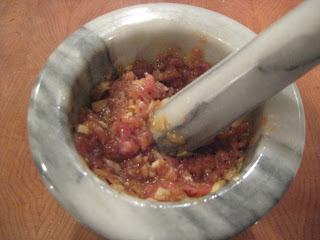add a few drops of olive oil.
This soffritto employs the battuto technique. A battuto—which literally translates to pound or hit —involves pounding two or more ingredients into a paste thereby releasing their flavours. In her book, The Oxford Companion to Italian Food, Gillian Riley attributes the battuto technique to the ingenuity which can derive from poverty. Riley points out that adding water to a battuto is an alternative to a meat broth and a good example behind the inventiveness of cucina povera; meat being a rare staple in the average Italian kitchen in the early 1900’s. A traditional battuto usually consisted of a cured meat, such as lardo or pancetta, and some chopped vegetables.
The battuto in this recipe will infuse your broth with the distinct smokiness of the bacon as well as accentuate its garlic flavour.
The battuto in this recipe will infuse your broth with the distinct smokiness of the bacon as well as accentuate its garlic flavour.

Soffritto #2
Lentil, Sausage, Cheddar and Ale Soup
Serves 4
2 strips of bacon, sliced small
3 garlic cloves, diced small
2 Tbsp olive oil
1 onion, diced small
2 celery stalks, diced small
2 carrots, diced small
4 Italian sausages, casings removed
1 bottle of beer,
1 ½ cups of whole milk
1 ½ cups of chicken broth
1 540ml can of lentils
½ cup grated cheddar cheese
2 tbsp Worcestershire sauce
Salt and pepper
Directions:
In a pestle and mortar, pound the bacon, garlic and some freshly ground black pepper into a paste.
In a large heavy bottom pot, heat the olive oil over medium high heat. When oil is hot add the onion, celery, carrots and sausage and sauté for 8 to 10 minutes. Add the battuto and cook another 2 to 3 minutes.
Add the beer, milk, chicken broth, and lentils and bring to a boil. Add the cheese and Worcestershire and stir. Keep stirring until cheese is completely melted and incorporated into the broth. Season with salt and pepper to your liking and garnish with some freshly chopped Italian parsley.
Lentil, Sausage, Cheddar and Ale Soup
Serves 4
Ingredients:
2 strips of bacon, sliced small
3 garlic cloves, diced small
2 Tbsp olive oil
1 onion, diced small
2 celery stalks, diced small
2 carrots, diced small
4 Italian sausages, casings removed
1 bottle of beer,
1 ½ cups of whole milk
1 ½ cups of chicken broth
1 540ml can of lentils
½ cup grated cheddar cheese
2 tbsp Worcestershire sauce
Salt and pepper
Directions:
In a pestle and mortar, pound the bacon, garlic and some freshly ground black pepper into a paste.
In a large heavy bottom pot, heat the olive oil over medium high heat. When oil is hot add the onion, celery, carrots and sausage and sauté for 8 to 10 minutes. Add the battuto and cook another 2 to 3 minutes.
Add the beer, milk, chicken broth, and lentils and bring to a boil. Add the cheese and Worcestershire and stir. Keep stirring until cheese is completely melted and incorporated into the broth. Season with salt and pepper to your liking and garnish with some freshly chopped Italian parsley.
Note. It's a good idea to heat the milk before adding it to the boiling broth in order to reduce the chance of it curdling. If it does curdle, add a pinch of salt before adding the cheese. (The fat in the cheese will also help if any curdling should occur.)
